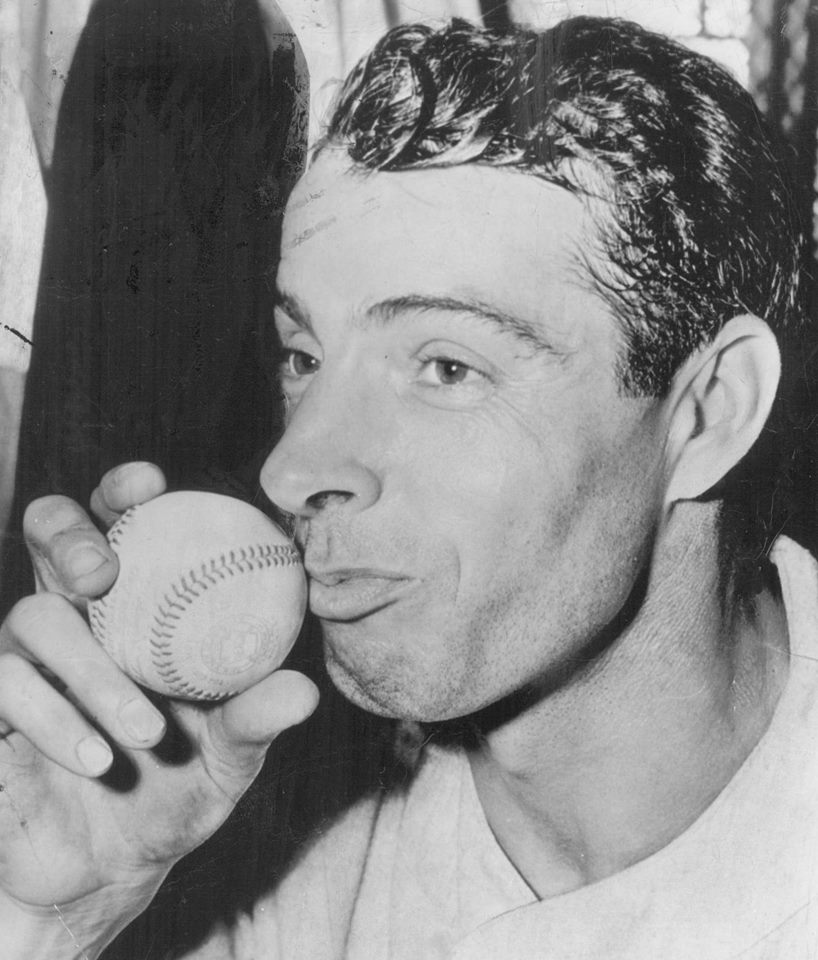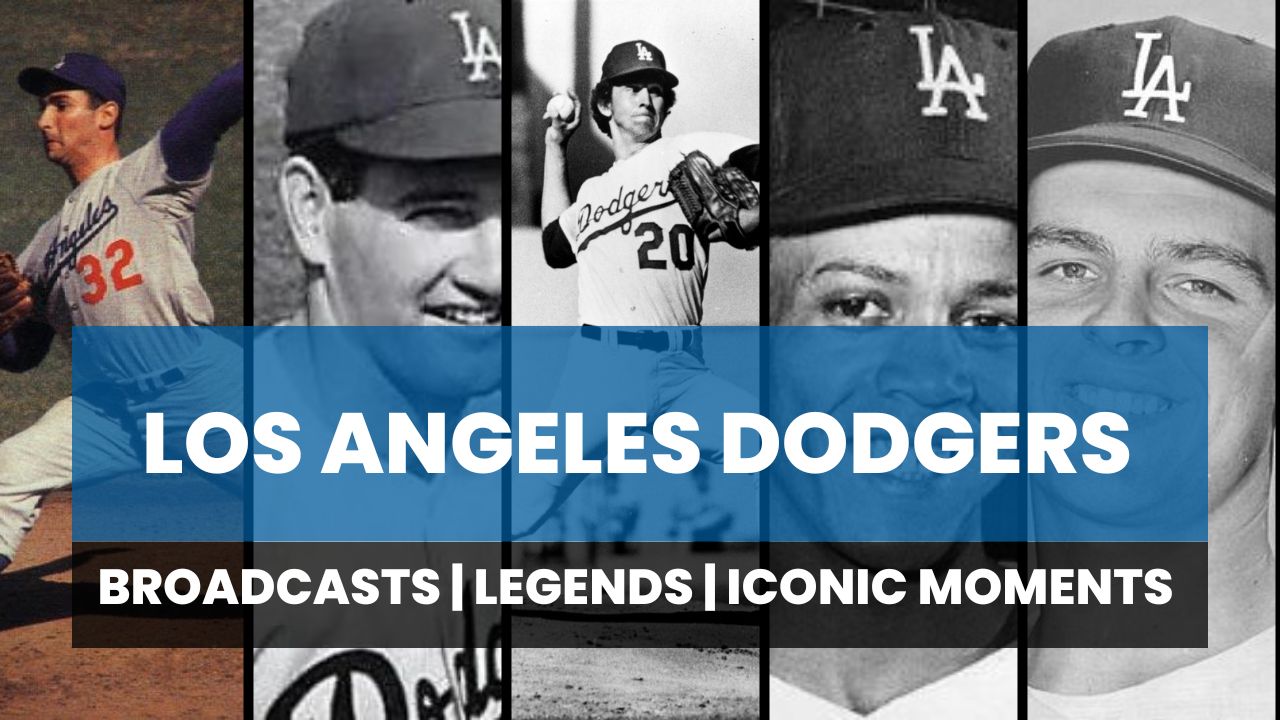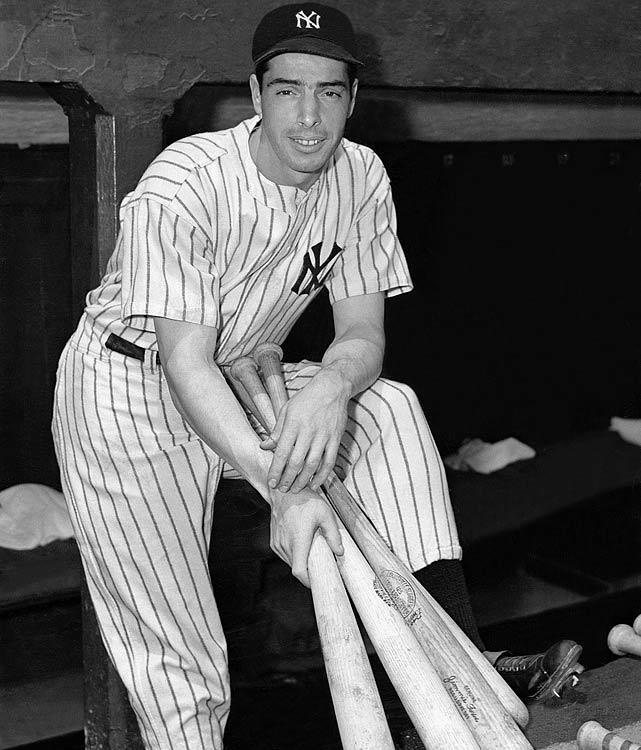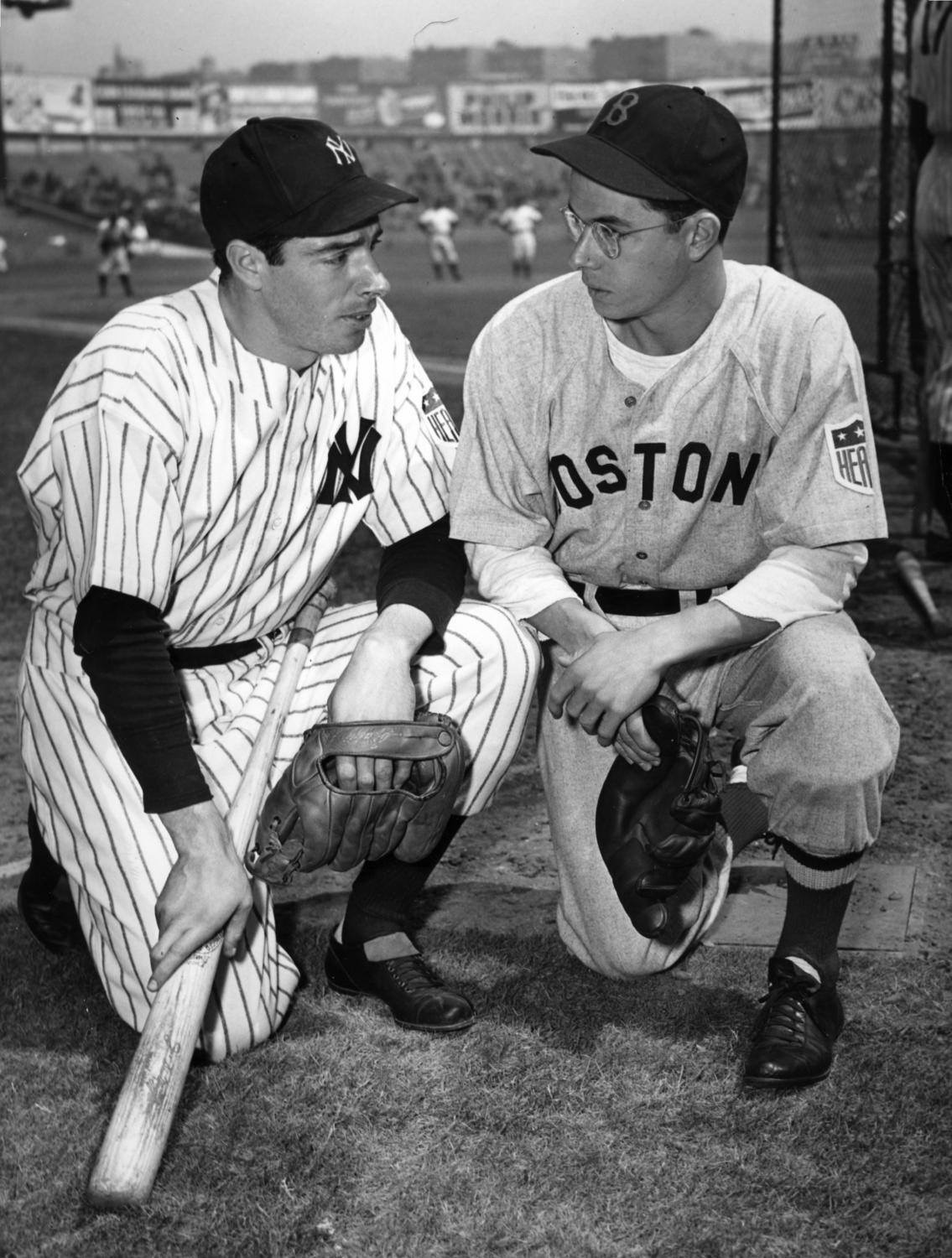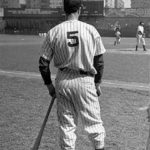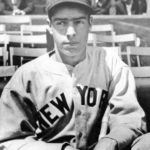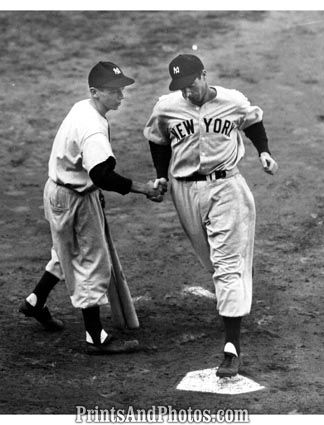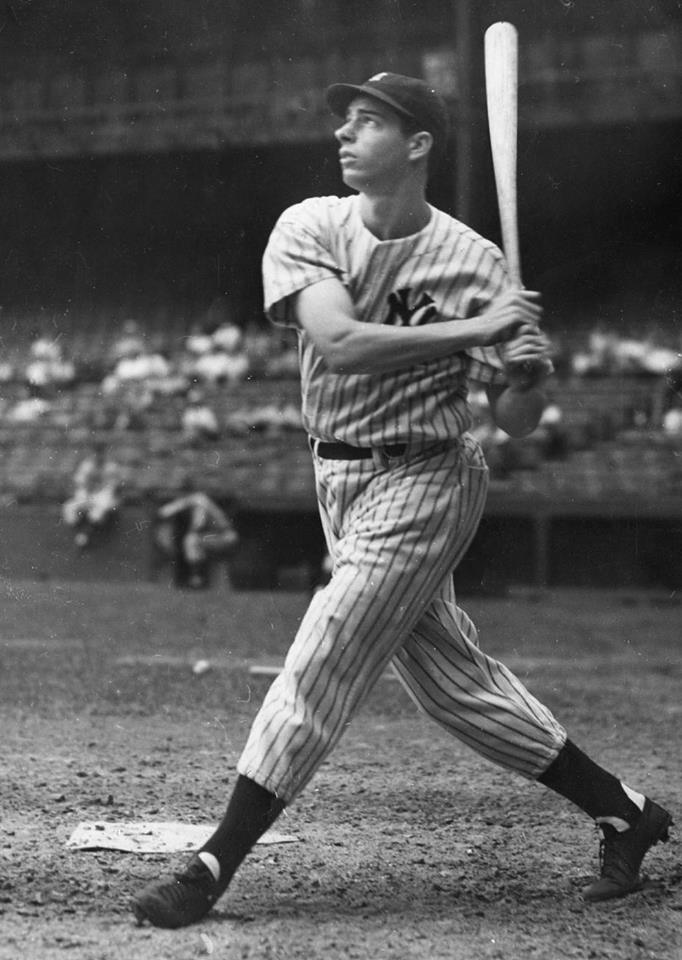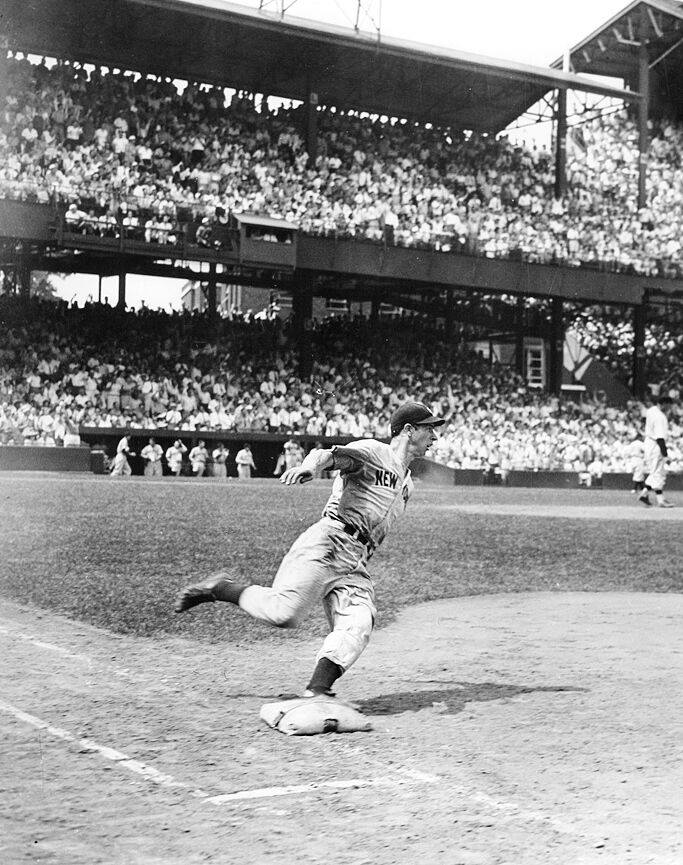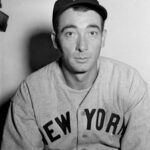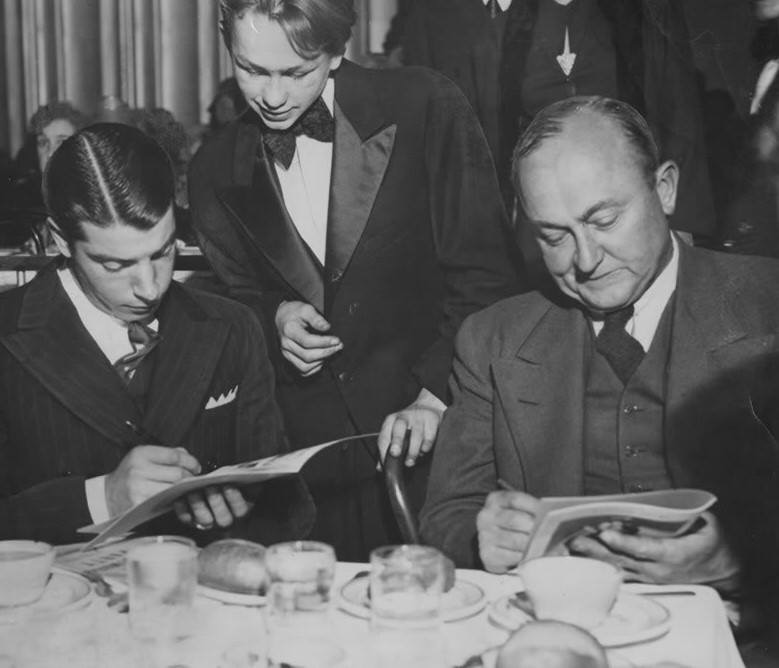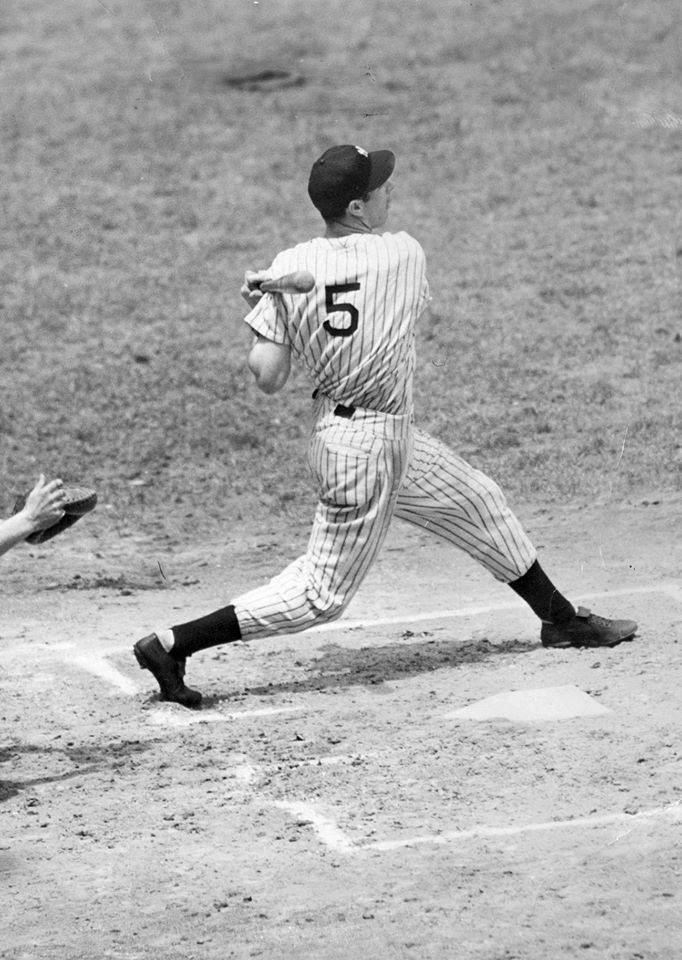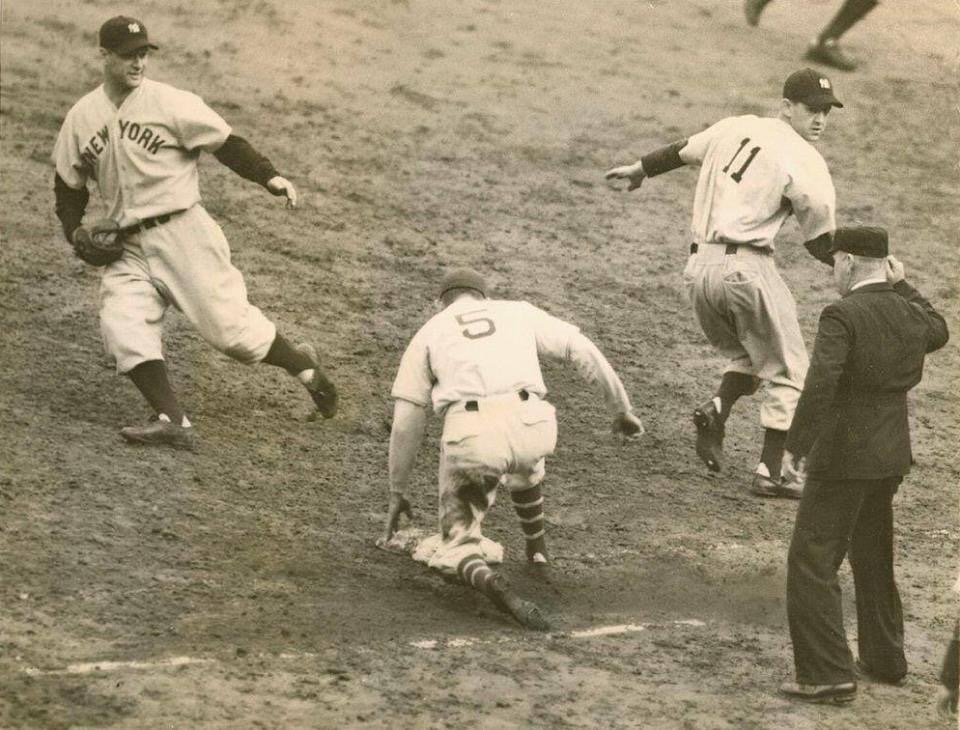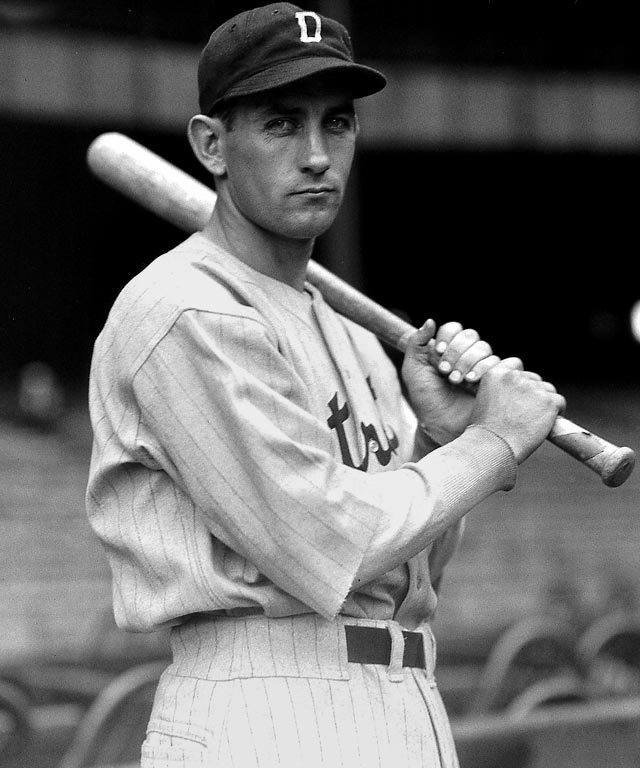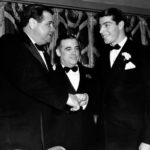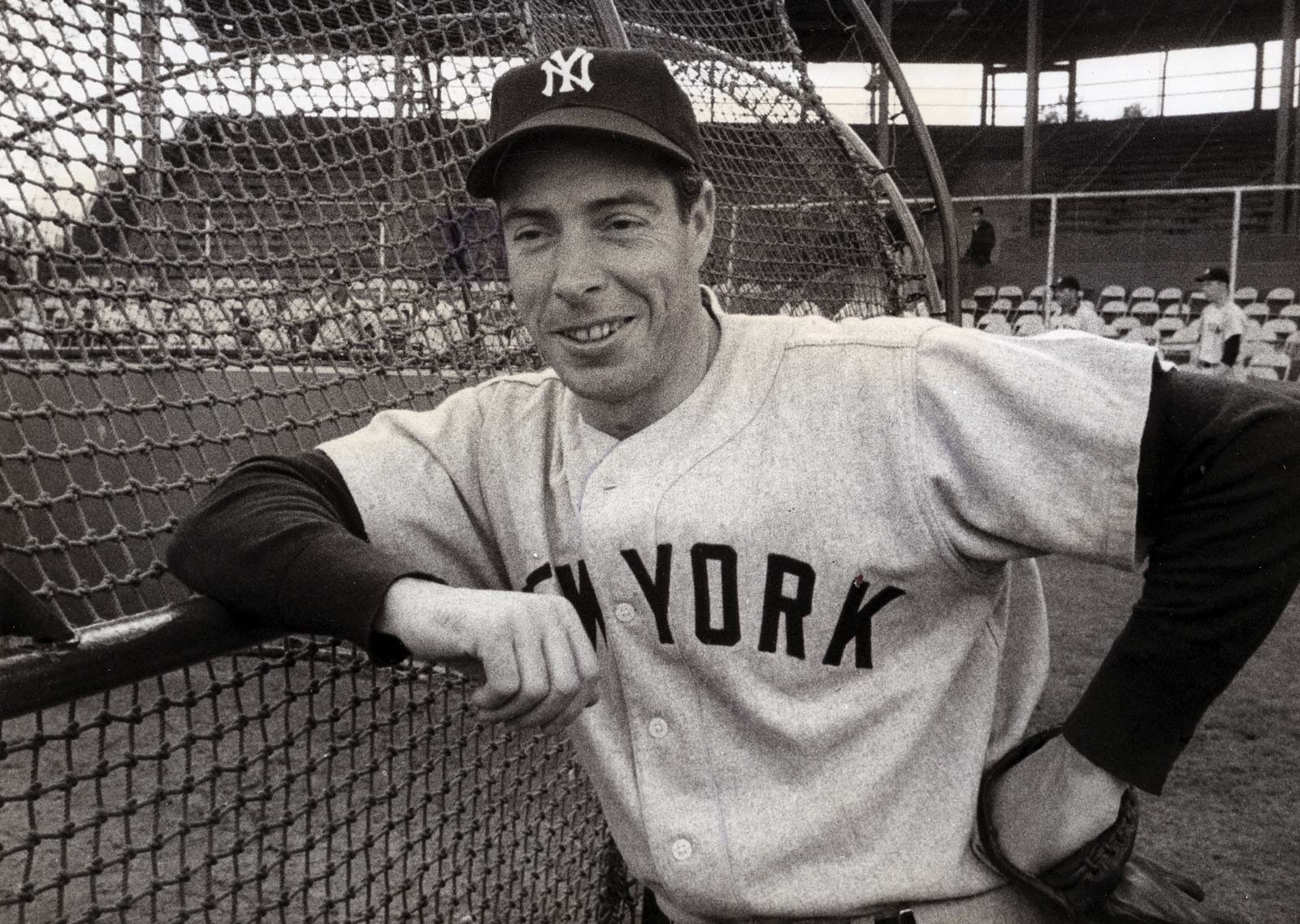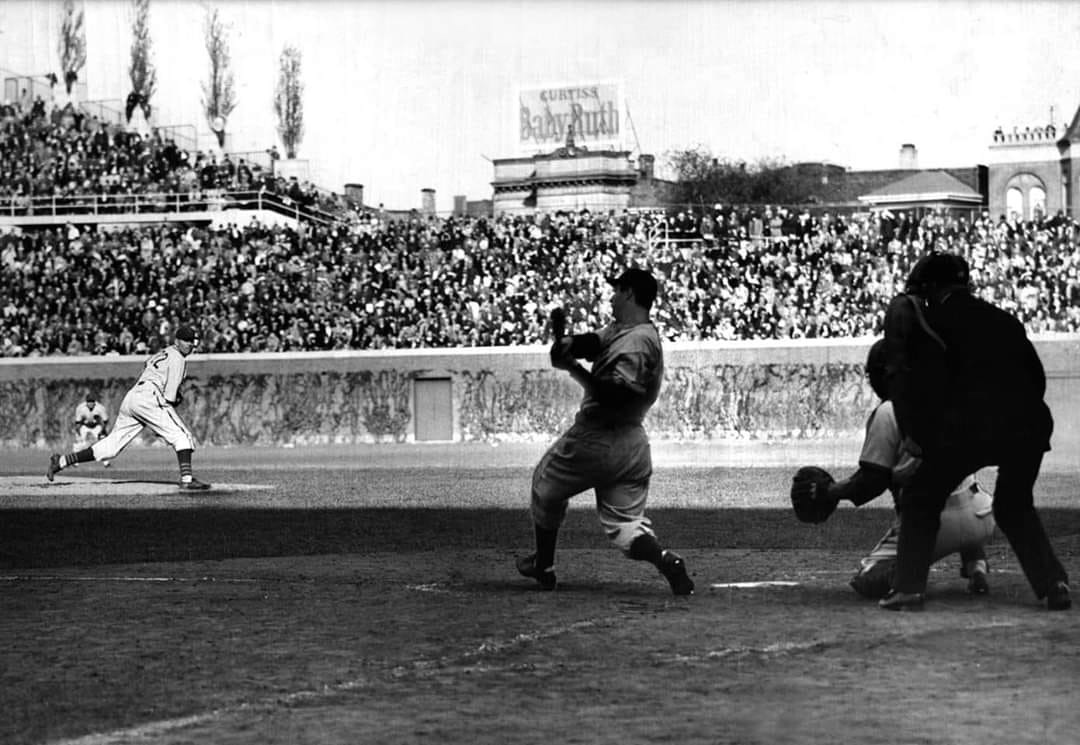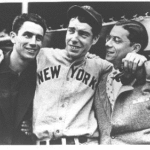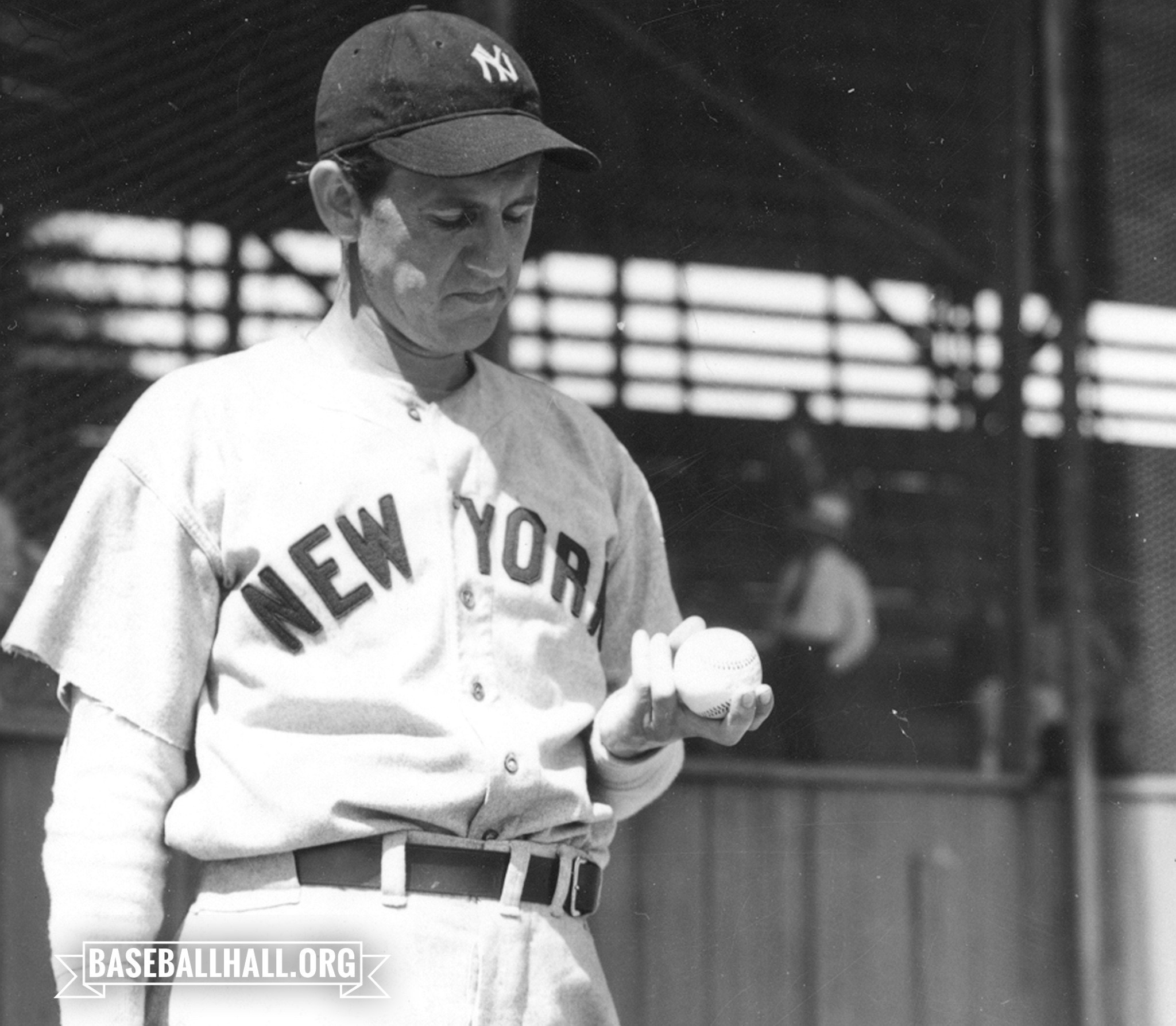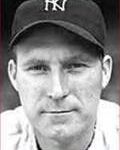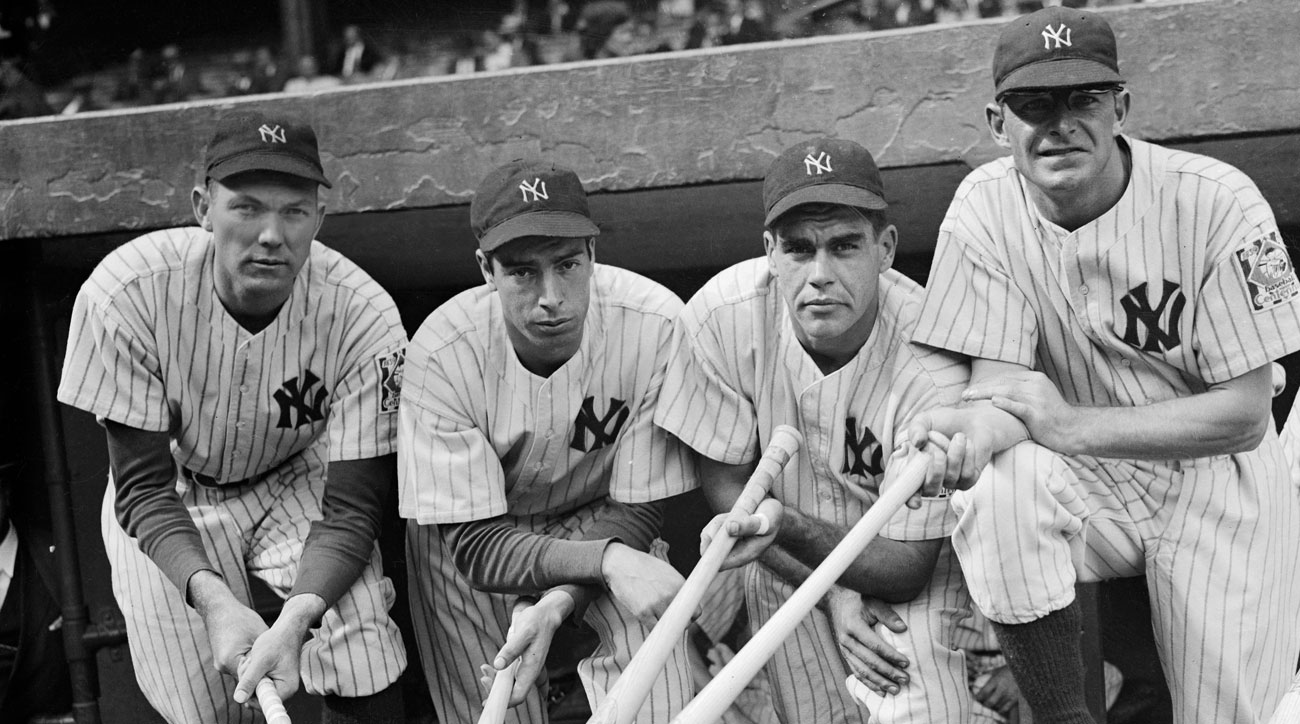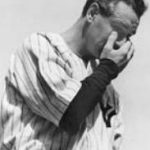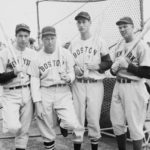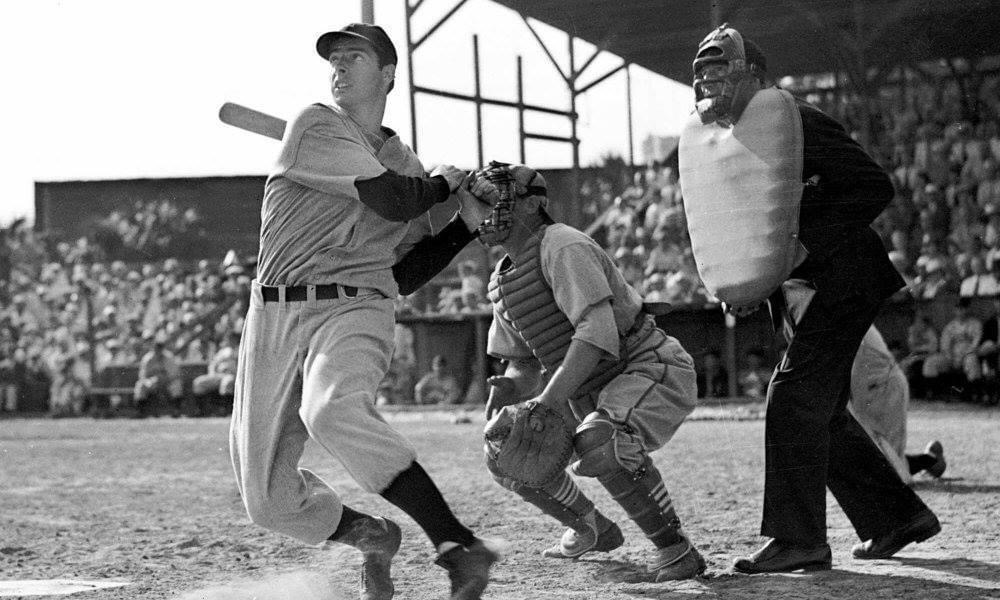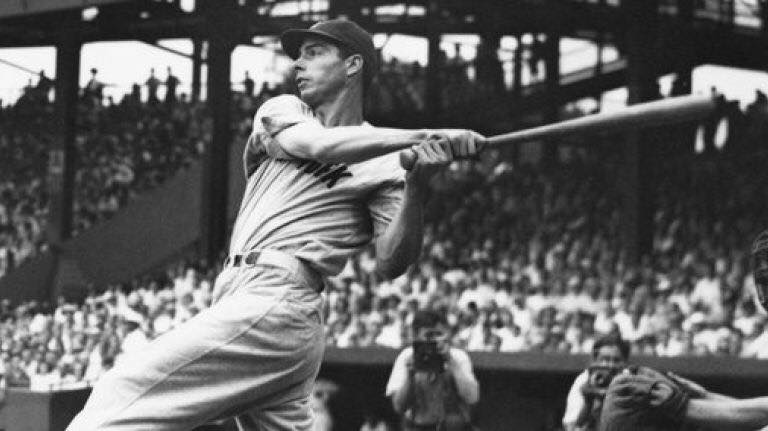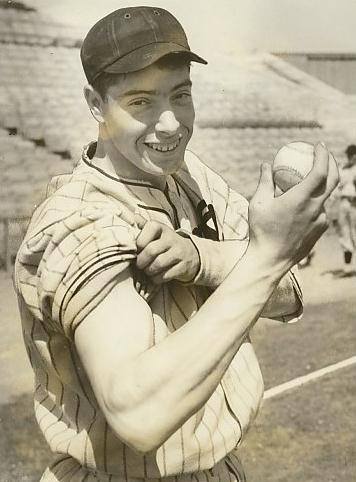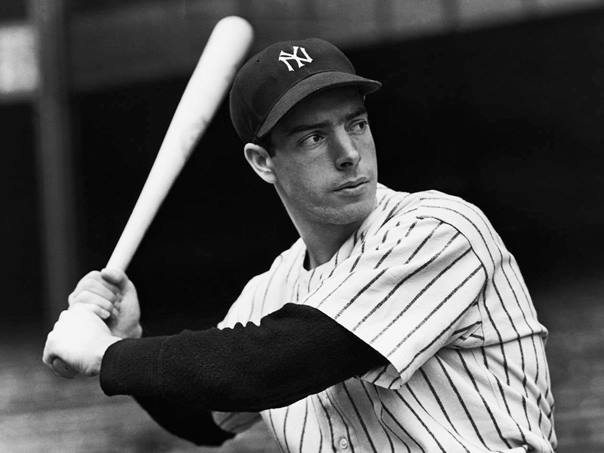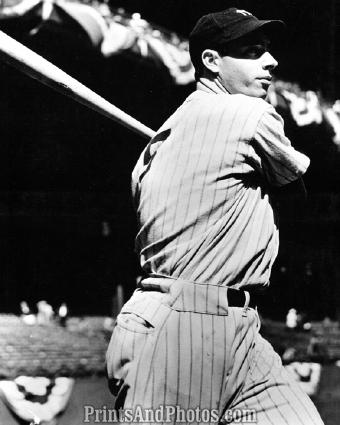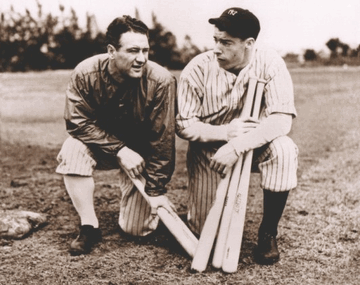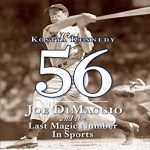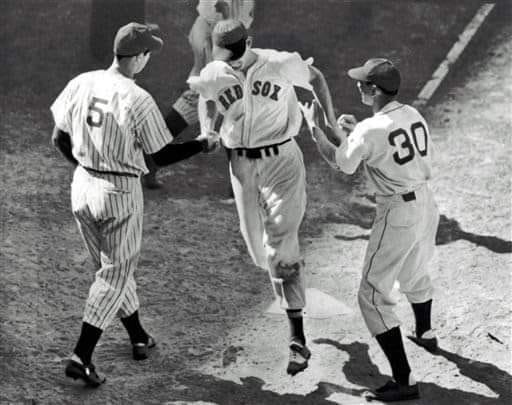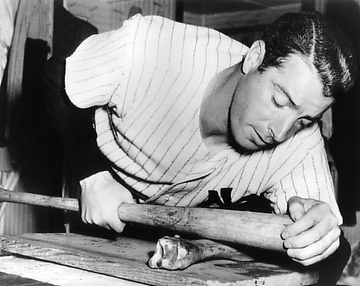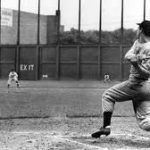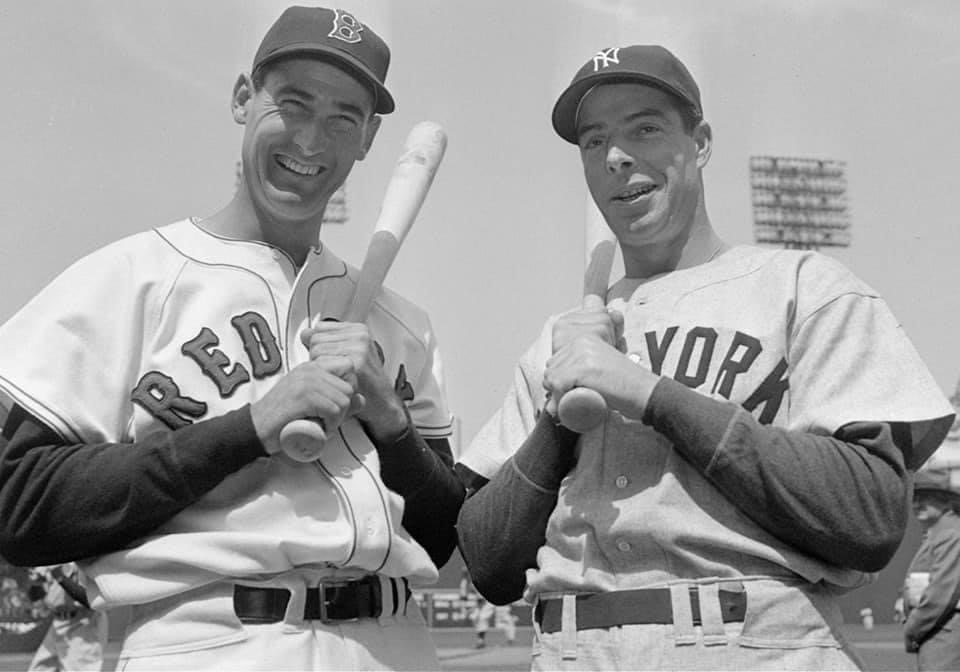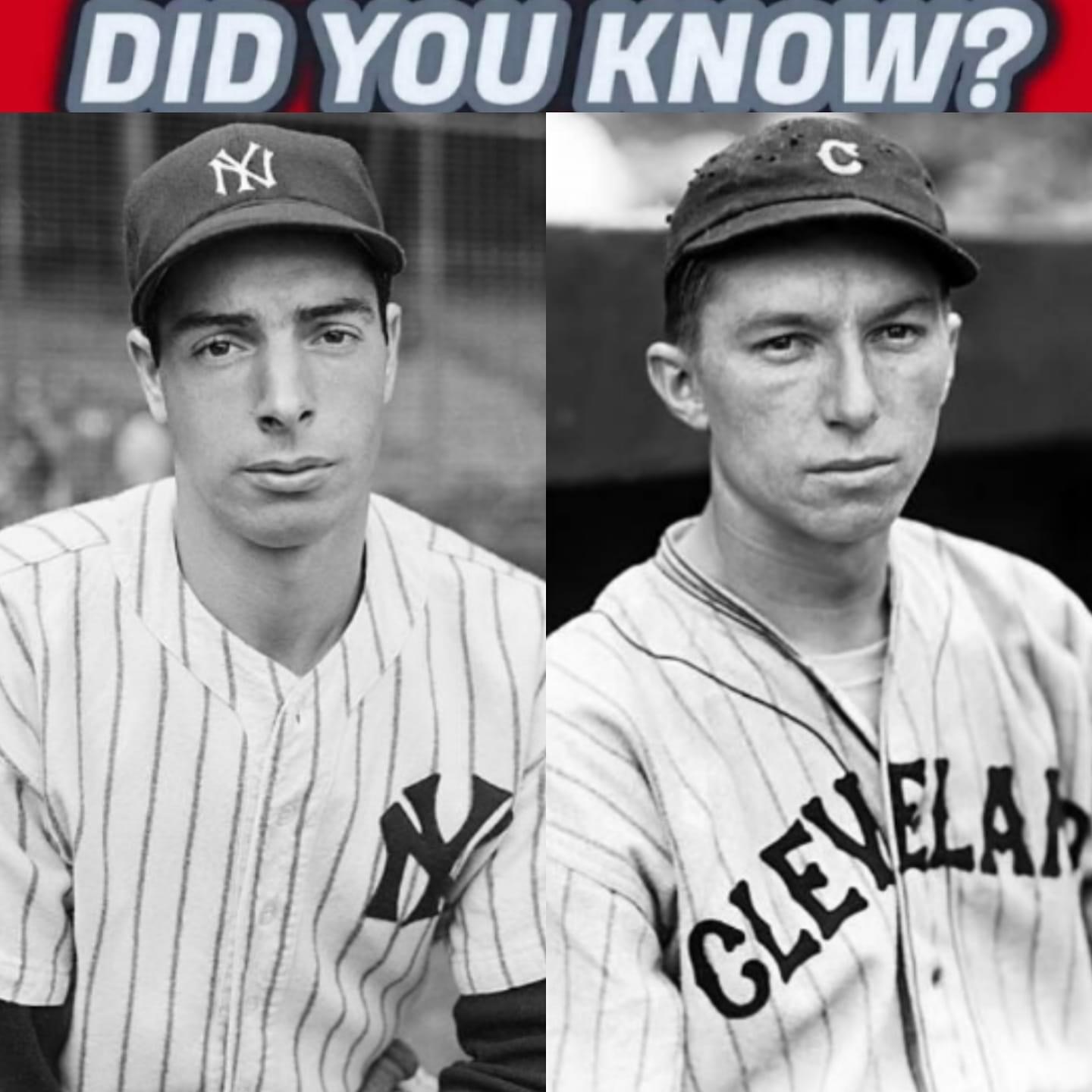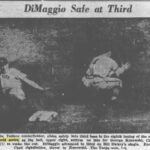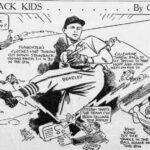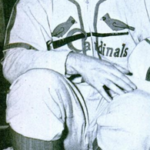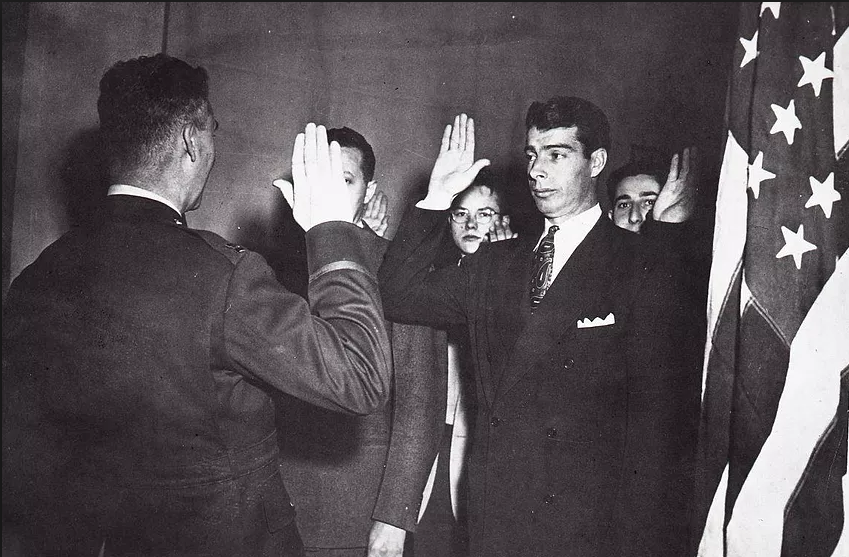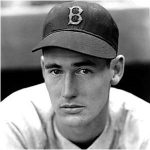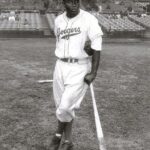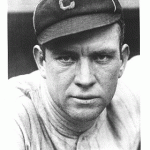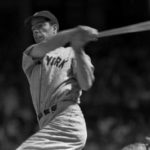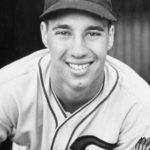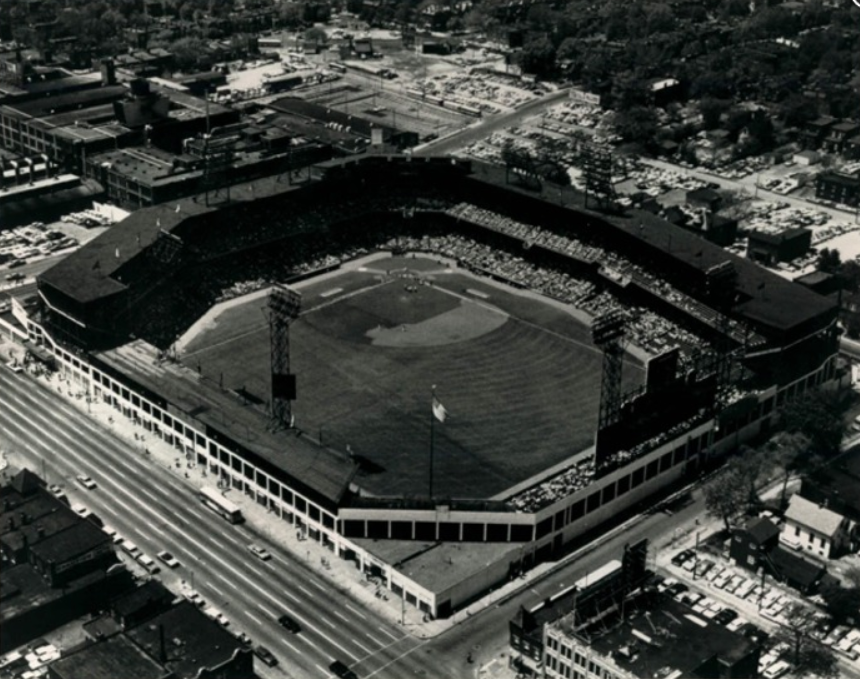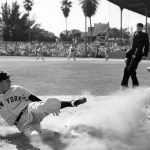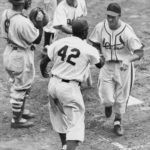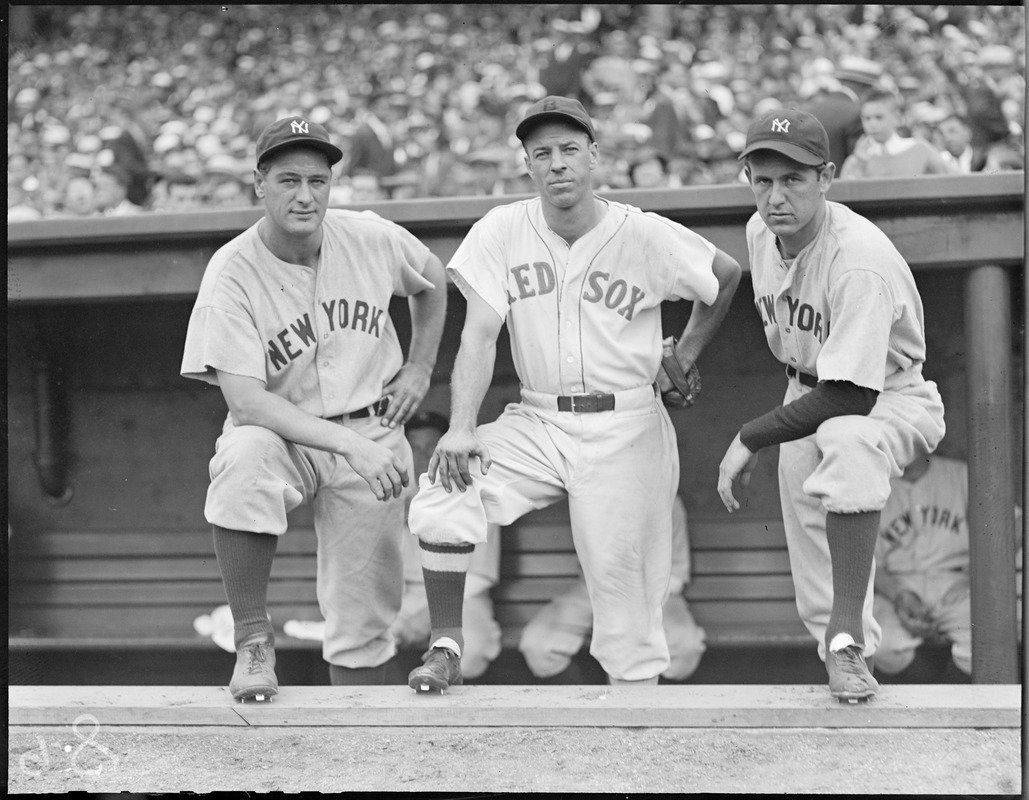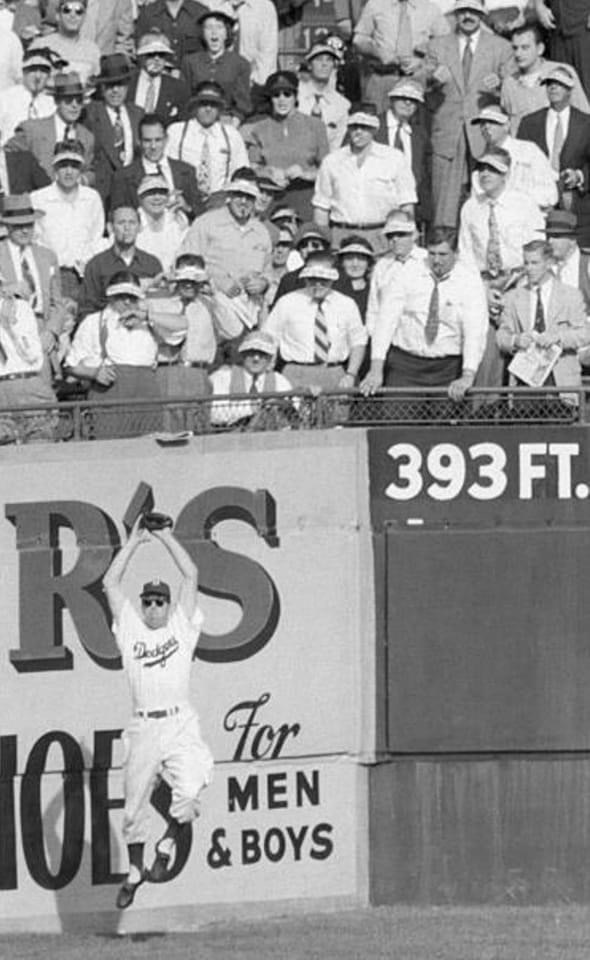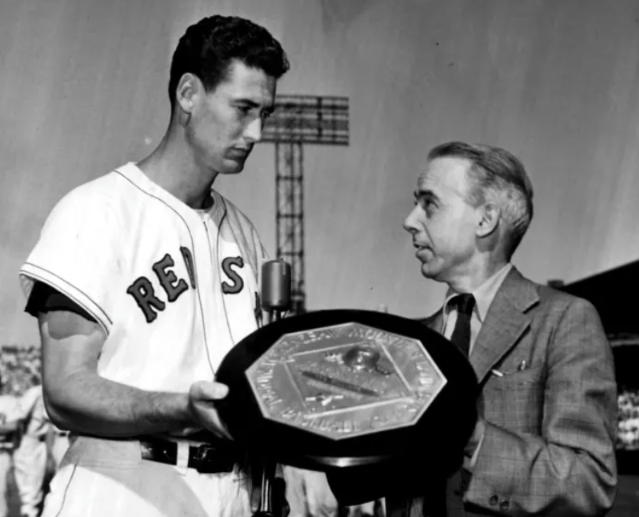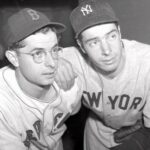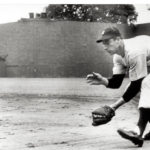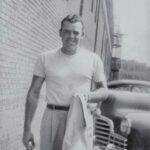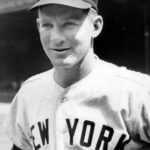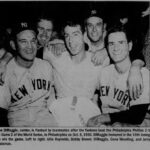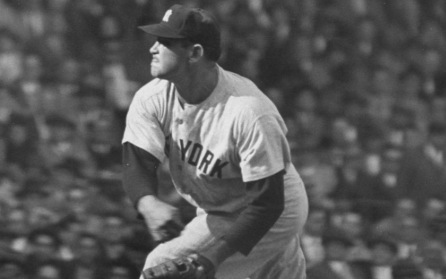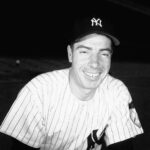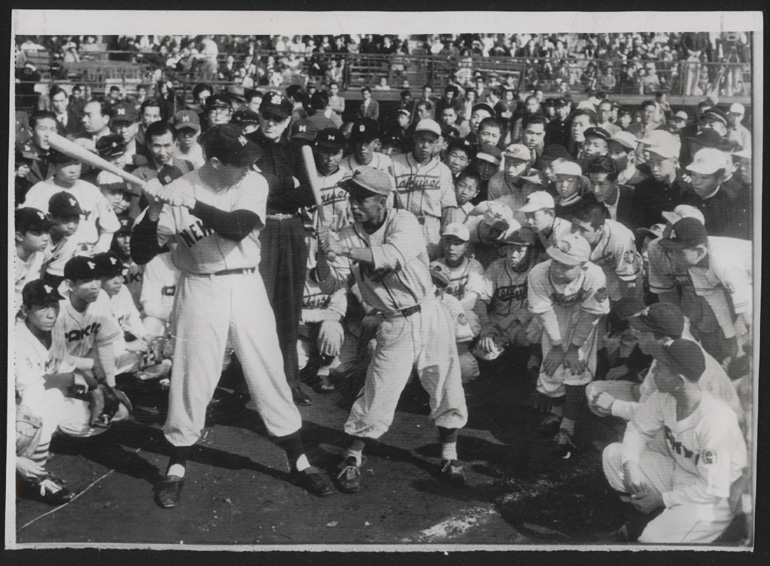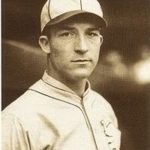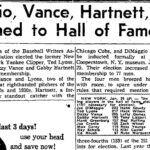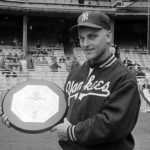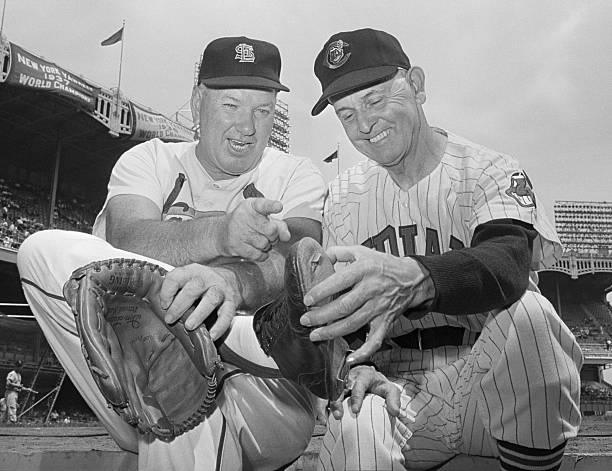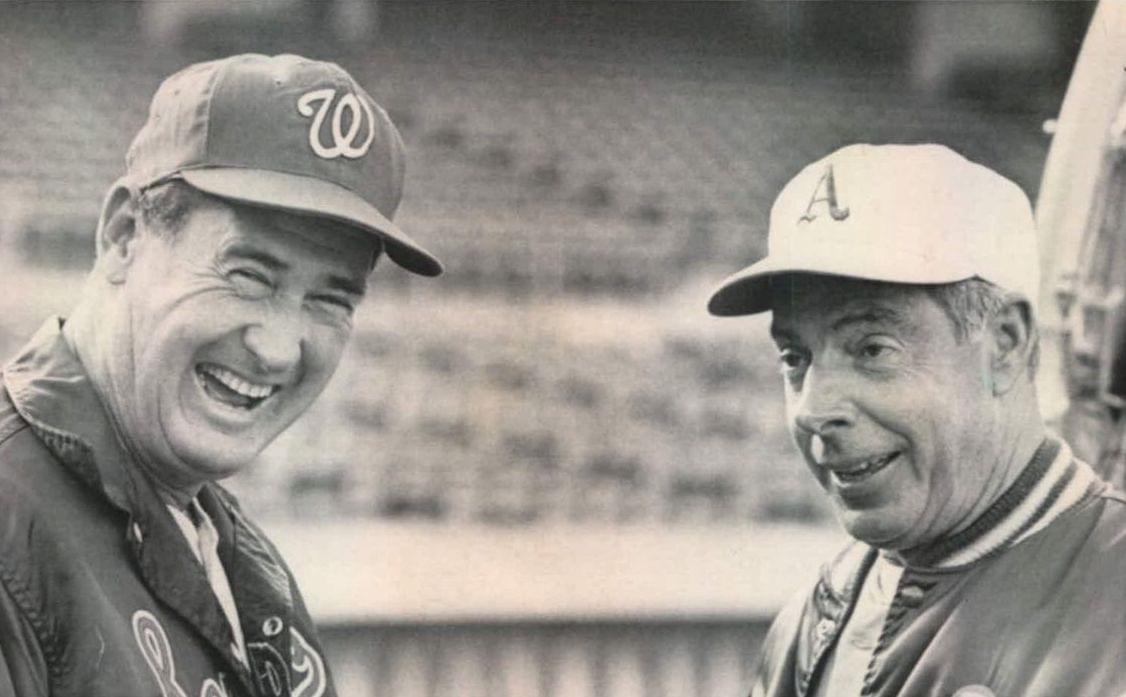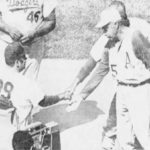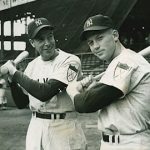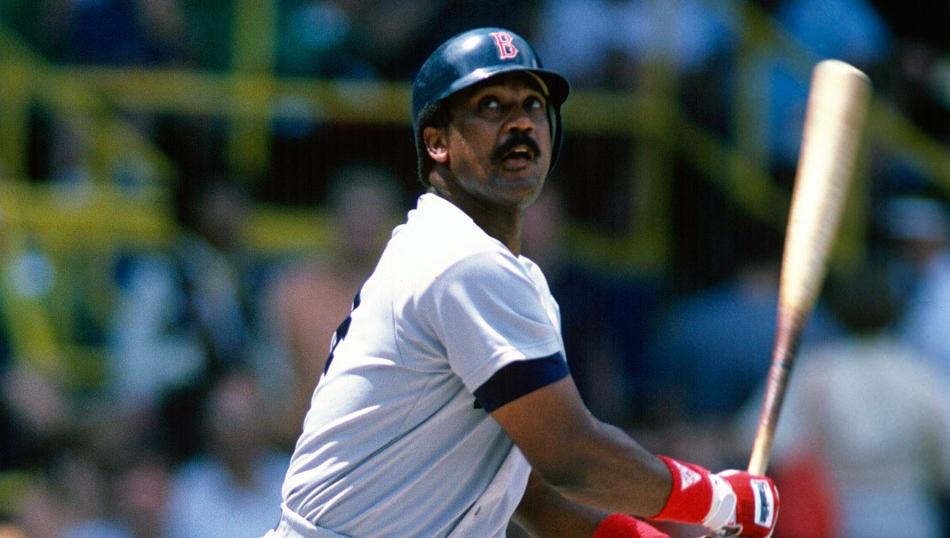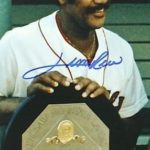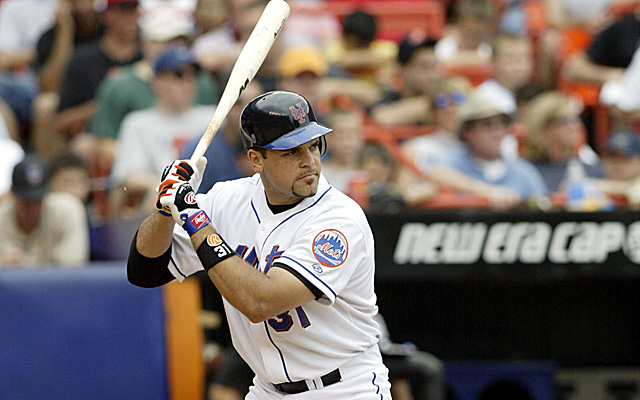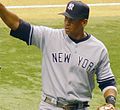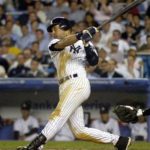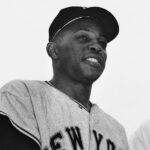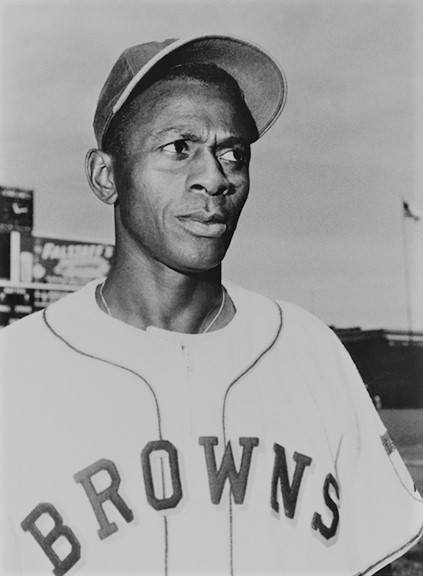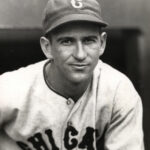Joe DiMaggio Biography
Joe DiMaggio
Position: Centerfielder
Bats: Right • Throws: Right
6-2, 193lb (188cm, 87kg)
Born: November 25, 1914 in Martinez, CA us
Died: March 8, 1999 in Hollywood, FL
Buried: Holy Cross Cemetery, Colma, CA
High School: Galileo HS (San Francisco, CA)
Debut: May 3, 1936 (8,006th in major league history)
vs. SLB 6 AB, 3 H, 0 HR, 1 RBI, 0 SB
Last Game: September 30, 1951
vs. BOS 1 AB, 1 H, 0 HR, 0 RBI, 0 SB
Hall of Fame: Inducted as Player in 1955. (Voted by BBWAA on 223/251 ballots)
View Joe DiMaggio’s Page at the Baseball Hall of Fame (plaque, photos, videos).
Rookie Status: Exceeded rookie limits during 1936 season
Full Name: Joseph Paul DiMaggio<
Nicknames: Joltin’ Joe or The Yankee Clipper
View Player Info from the B-R Bullpen
View Player Bio from the SABR BioProject
Relatives: Brother of Dom DiMaggio, Vince DiMaggio
Nine Players Who Debuted in 1936
Johnny Mize
Joe DiMaggio
Bill Nicholson
Eddie Joost
George McQuinn
Jeff Heath
Bob Feller
Nels Potter
Birdie Tebbetts
The Joe DiMaggio Teammate Team
C: Bill Dickey
1B: Lou Gehrig
2B: Joe Gordon
3B: Red Rolfe
SS: Phil Rizzuto
LF: Tommy Henrich
CF: Mickey Mantle
RF: Charlie Keller
SP: Lefty Gomez
SP: Red Ruffing
SP: Allie Reynolds
SP: Vic Raschi
RP:
M: Joe McCarthy
Notable Events and Chronology for Joe DiMaggio Career
The most complete player of his era, Joe DiMaggio is considered by most baseball historians to be the first true “five-tool” player ever to grace a major league ballfield. In fact, prior to leaving the game for three years to serve in the military during World War II, DiMaggio may well have been the greatest all-around player in baseball history. His tremendous ability, along with the stylish grace and elegance he exhibited while patroling centerfield in Yankee Stadium for 13 seasons, eventually enabled The Yankee Clipper to reach iconic-like status, turning him into a true American hero.
Born Giuseppe Paolo DiMaggio Jr., the eighth of nine children to Italian immigrants, Joseph Paul DiMaggio had already made a name for himself in his native California by the time he joined the New York Yankees in 1936. Honing his baseball skills under the watchful eye of former major league outfielder Lefty O’Doul while playing for the San Francisco Seals from 1933 to 1935, DiMaggio became a West Coast legend by hitting in a Pacific Coast League record 61 consecutive games from May 27 to July 25, 1933. DiMaggio later said, “Baseball didn’t really get into my blood until I knocked off that hitting streak. Getting a daily hit became more important to me than eating, drinking or sleeping.”
DiMaggio joined the Yankees prior to the start of the 1936 season, after being purchased for $25,000 and five players. He made his major league debut on May 3, 1936, batting third in the New York lineup, just ahead of Lou Gehrig. The Yankees hadn’t won the American League pennant since 1932, but, with Gehrig and DiMaggio leading the way, they captured the first of four consecutive world championships in the brilliant rookie’s first year with the team. Displaying his vast array of skills, DiMaggio excelled both in the field and at the bat. He intimidated opposing baserunners with his powerful throwing arm, accumulating a league-leading 22 outfield assists, while also establishing himself as one of the game’s top offensive performers by hitting 29 homers, driving in 125 runs, scoring 132 others, batting .323, and compiling 206 hits, 44 doubles, and a league-leading 15 triples. DiMaggio’s exceptional all-around performance earned him the first of 13 selections to the All-Star Team and an eighth-place finish in the A.L. MVP voting.
DiMaggio was even better in his second year in the league, with the 22-year-old outfielder having perhaps the finest season of his career. Despite playing in spacious Yankee Stadium, noted for its distant fences in both left-center and centerfield, the righthanded-hitting DiMaggio slugged a league-leading 46 home runs, knocked in 167 runs, topped the circuit with 151 runs scored, batted .346, stroked 215 hits and 15 triples, and led the league with 418 total bases and a .673 slugging percentage. He also compiled more than 20 assists in the outfield for the second of three consecutive times. For his efforts, DiMaggio was awarded a second-place finish in the league MVP voting.
DiMaggio continued to build on his reputation as the finest all-around player in the game over the course of the next three seasons, leading New York to the world championship in both 1938 and 1939. In the first of those years, he hit 32 homers, drove in 140 runs, scored 129 others, and batted .324. After drawing the ire of the fans early in 1939 for missing the first few weeks of the season due to a contract dispute, DiMaggio demonstrated that he was well worth the money he extracted from the Yankee front office. The game’s greatest player not only led the league with a career-high .381 batting average, but also hit 30 home runs and drove in 126 runs, in only 120 games and 462 official at-bats. DiMaggio was named the league’s Most Valuable Player for his extraordinary performance. He then won his second straight batting title the following year, hitting .352, while also clubbing 31 homers and knocking in 133 runs, to earn a third-place finish in the league MVP balloting.
It was in 1941, though, that The Yankee Clipper became a true American folk hero. He edged out Ted Williams (who batted .406 for the Red Sox that year) for league MVP honors by hitting 30 home runs, scoring 122 runs, batting .357, and driving in a league-leading 125 runs, en route to leading the Yankees to their fifth world championship in his first six years with the team. More importantly, DiMaggio carved out a permanent place for himself in both the record books and in mainstream American culture by hitting in a major league record 56 consecutive games. As DiMaggio continued to hit in game after game from May 15 to July 16, he reached legendary status, prompting songs to be written about him and transposing himself into more than just a baseball player. He became the idol of millions and arguably the most famous man in America. Adding to his glorification was the DiMaggio “mystique”, an aura that seemed to surround him as he glided gracefully after fly balls in the outfield, slugged home runs with a near-perfect swing, moved swiftly but effortlessly around the bases, and carried himself majestically both on and off the field. Not only did fans of the game look up to DiMaggio, but other players admired and respected him as well.
Stan Musial, certainly one of the greatest players ever to don a major league uniform, expressed his reverence for The Yankee Clipper when he stated, “There was never a day when I was as good as Joe DiMaggio at his best. Joe was the best, the very best I ever saw.”
Ted Williams, to whom DiMaggio was often compared, said, “DiMaggio was the greatest all-around player I ever saw. I give it to him over Mays (Willie) simply because he was a better hitter than Mays. I saw him play, I saw what he could do, and I’m positive that he was a better hitter than Mays.”
Williams continued to express his admiration for DiMaggio by saying, “I can’t say enough about DiMaggio. Of all the great major leaguers I played with or against during my 19-year career, he was my idol. I idolized Joe DiMaggio!”
DiMaggio had something of an off-year in his final season before joining the war effort. Although he drove in 114 runs and scored 123 others in 1942, he hit “only” 21 homers and batted “just” .305. Clearly not the same player after he returned to the major leagues in 1946, DiMaggio batted only .290, with just 25 home runs, 95 runs batted in, and 81 runs scored. Despite being named A.L. MVP for the third and final time in 1947, DiMaggio actually posted sub-par numbers once again, hitting just 20 homers, driving in only 97 runs, and batting .315. However, Joltin’ Joe showed he still had something left the following year, batting .320, scoring 110 runs, and leading the American League with 39 home runs and 155 runs batted in, to earn a second-place finish in the league MVP voting.
The 1948 campaign was DiMaggio’s last great season. Injuries cut into his playing time significantly in each of his last three years, although he remained an extremely productive player to the very end. After missing half of the 1949 campaign with an injured in-step, DiMaggio returned to the Yankee lineup to bat .346, hit 14 home runs and drive in 67 runs over the team’s final 76 games. He followed that up by clubbing 32 homers, knocking in 122 runs, scoring 114 others, and batting .301 in 1950. DiMaggio batted just .263, with only 12 homers and 71 RBIs in 1951, prompting him to announce his retirement at the end of the season. In making the announcement, DiMaggio declared, “I made a solemn promise to myself that I wouldn’t try to hang on once the end was in sight. It wasn’t easy to pass up $100,000, but with me it was all or nothing…I feel like I have reached the stage where I can no longer produce for my club, my manager, and my teammates. I had a poor year, but even if I had hit .350, this would have been my last year. I was full of aches and pains and it has become a chore for me to play. When baseball is no longer fun, it’s no longer a game, and so, I’ve played my last game.”
DiMaggio’s great pride caused him to leave the game at age 36, when he probably could have played another two or three seasons. He refused to allow himself to perform at a level that wasn’t up to the expectations either he or the fans set for himself. DiMaggio often said that he felt a need to always play his very best because there might be one person in the stands who never saw him play before, and he wanted to make certain that he left a favorable impression on that one fan.
Later in life, the level of importance DiMaggio placed on his public image, his obsessive and somewhat narcissistic nature, and revelations regarding his preoccupation with money caused much of the luster to be rubbed off the DiMaggio mystique. Yet, he remained an iconic-like figure until he died on March 8, 1999. And although later generations of fans came to widely accept the notion that Willie Mays and a few others may have been slightly better all-around players, there is little doubt that the man named Baseball’s Greatest Living Player in a 1969 poll conducted to coincide with the centennial of professional baseball was one of the greatest players who ever lived. In addition to winning three Most Valuable Player Awards, DiMaggio finished in the top 10 in the voting seven other times. He is the only player in baseball history to be selected to the All-Star Team in every season in which he played, and he was also named to The Sporting News All-Star Team a total of eight times. DiMaggio led the American League in home runs, runs batted in, batting average, and slugging percentage two times each, he topped the circuit in total bases three times, and he finished first in triples and runs scored once each. He surpassed 30 homers in seven of his 13 seasons, drove in more than 100 runs nine times, knocking in at least 125 runs on seven separate occasions, scored more than 100 runs eight times, batted at least .320 eight different times, and finished in double-digits in triples eight times. Perhaps the most amazing thing about DiMaggio is that he hit 361 home runs and struck out a total of only 369 times during his career. Considered to be one of the greatest defensive centerfielders in baseball history, DiMaggio was an instinctive and graceful outfielder who possessed both outstanding speed and a powerful throwing arm. Although he was rarely called upon to steal bases, DiMaggio was also generally regarded as the finest baserunner of his day.
Some of the luster may have been rubbed off the DiMaggio mystique in recent years, but he remains one of the most heroic figures in baseball history. Ted Williams writes in his book The Hit List, “Joe DiMaggio’s career cannot be summed up in numbers and awards. It might sound corny, but he had a profound and lasting impact on the country. How many athletes can make that claim? Despite what Simon and Garfunkel sang about him, every baseball fan knows that DiMaggio could never really leave us. For many fans he’s become baseball’s knight in shining pinstripe armor. Hell, for some he was almost the embodiment of the American dream.”
@ET-DC@eyJkeW5hbWljIjp0cnVlLCJjb250ZW50IjoicG9zdF90YWdzIiwic2V0dGluZ3MiOnsiYmVmb3JlIjoiTGVhcm4gTW9yZSBhYm91dCB0aGUgdGVhbXMsIHBsYXllcnMsIGJhbGwgcGFya3MgYW5kIGV2ZW50cyB0aGF0IGhhcHBlbmVkIG9uIHRoaXMgZGF0ZSBpbiBoaXN0b3J5IC0gLSAtIC0gLSAtIC0gIiwiYWZ0ZXIiOiIiLCJsaW5rX3RvX3Rlcm1fcGFnZSI6Im9uIiwic2VwYXJhdG9yIjoiIHwgIiwiY2F0ZWdvcnlfdHlwZSI6InBvc3RfdGFnIn19@
Factoids, Quotes, Milestones and Odd Facts
Played For
New York Yankees (1936-1951)
Similar: None, though Paul Molitor was compared to DiMaggio by Ted Williams.
Linked: Lou Gehrig, Ted Williams, Dom DiMaggio, Vince DiMaggio, Al Gianfriddo, Mickey Mantle, Pete Rose
Best Season, 1941
Though Ted Williams great ’41 season denied DiMaggio a batting or slugging title, Joltin’ Joe had a monster year. He slugged .643 with a .440 OBP (1.083 OPS). He led the league with 125 RBI, and hit 30 homers and 43 doubles. He also scored 122 runs, collected 193 hits, and smashed 11 triples. Amazingly, he struck out just 13 times! He had 76 walks, and did all of this while playing his usual fantastic center field. Oh yes…and he also posted his 56-game hitting streak and led the Yankees to a World Series title.
Awards and Honors
1939 AL MVP
1941 AL MVP
1947 AL MVP
Post-Season Appearances
1936 World Series
1937 World Series
1938 World Series
1939 World Series
1941 World Series
1942 World Series
1947 World Series
1949 World Series
1950 World Series
1951 World Series
Factoid
Joe DiMaggio’s 56-game hitting streak was stopped by Cleveland pitcher Jim Bagby Jr., son of former big league pitcher Jim Bagby. In the minor leagues, DiMaggio had a 61-game hitting streak stopped by Ed Walsh Jr., son of Hall of Fame right-hander Ed Walsh.
Full Bio
DiMaggio’s 56-game hitting streak in 1941 remains one of baseball’s most cherished records. As a young player he teamed with Lou Gehrig to lead some of the best Yankee teams ever. As an older player he formed a powerful lineup with Johnny Mize and Yogi Berra. When he retired, young star Mickey Mantle arrived to fill his shoes. Baseball fans soon realized that no one would ever accomplish that.
According to many eye witnesses, DiMaggio was the best all-around player of his time. He could hit, hit for power, throw, field, and run. He bridged the Gehrig era to the Mantle era. He was a winner: playing on ten pennant winners and failing to win the World Series just once in those ten tries.
He retired when he could have played a few more years and won some more titles. But that wasn’t his style. He moved aside to make way for Mickey Mantle. Joe DiMaggio lived the life of an American Hero. In an amazing life as an American icon, DiMaggio married Hollywood star Marilyn Monroe, becoming the envy of every American male. Even after they split, DiMaggio remained in the spotlight as a spokesman for several products, including the Mr. Coffee maker.
DiMaggio came from a baseball family, his two brothers also were major leaguers. Dominic was the better of the two siblings, starring with the Red Sox, earning All-Star status and Hall of Fame support from teammate Ted Williams. Vince was best known for his defense and the long swing which led to him lead the league in strikeouts six times in his ten year career.
DiMaggio frequently battled the Yankees over his salary and was once almost traded straight up for Williams, in what would have been the biggest deal in baseball history. The Yankees benefited from his leadership, as DiMaggio helped break in Phil Rizzuto, Yogi Berra, and Mickey Mantle.
In 1969, as Major League Baseball celebrated the 100th anniversary of professional baseball, DiMaggio was voted the “Greatest Living Player.”
Minor League Experience
In his last minor league season, in 1935, DiMaggio hit 39 homers, 25 of them on the road, and 14 at Seals Stadium in San Francisco.
Big League Debut: May 3, 1936
Dimaggio’s debut was delayed by his contract holdout.
Feats: His record 56-game hitting streak has stood for more than 60 years.
Hitting Streaks
56 games (1941)
56 games (1941)
23 games (1940)
23 games (1940)
22 games (1937)
22 games (1937)
21 games (1937)
21 games (1937)
Chasing .400
As the 1939 season drew to a close, 24-year old Joe DiMaggio was on the brink of baseball history.
“I remember there were about three weeks to go in the season and I had a plus-.400 batting average,” Joe recalled in 1963. “I figured I was odds-on to finish the year with a .400 mark. I remember Joe McCarthy calling me into his office and telling me he didn’t think I wanted to be a cheese champion so he was going to play me every day, even though the pennant was about clinched.”
“I agreed, but a few days later I got this terrible pain over my right eye. I didn’t tell anyone, and I went to a doctor who gave me Novocain shots over the eye to kill the pain. I was taking a terrible chance, but I never thought of the consequences. All I wanted to do was stay in the lineup and hit .400. I didn’t make it though.”
DiMaggio finished the season at .381, winning his first batting title and Most Valuable Player Award.
Factoid
On September 13, 1946, Yankee Joe DiMaggio belted a home run to defeat the Detroit Tigers and eliminate them from the pennant race. His homer gave the pennant to the Boston Red Sox. BoSox players Dom DiMaggio, Bobby Doerr, and Tex Hughson sent DiMaggio a telegram in Detroit, which said: “Thanks a lot for that home run, pal!”
DiMaggio and the MVP Award
DiMaggio won two controversial MVP awards over Ted Williams: in 1941 (by 37 votes, despite Williams’ .406 average); and in 1947, (by a single vote). Twice he finished second, once in a very close vote. In 1937 he lost the honor to Detroit’s Charlie Gehringer by four votes.
1936 – 8th
1937 – 2nd
1938 – 6th
1939 – 1st
1940 – 3rd
1941 – 1st
1942 – 7th
1943-1945 (military)
1946 – 19th
1947 – 1st
1948 – 2nd
1949 – 12th
1950 – 9th
DiMaggio vs. Stengel
Late in his career, DiMaggio had a feud with Yankee manager Casey Stengel, whom he had little respect for. On July 8, 1951, after DiMaggio committed an error in center field, Stengel measured some revenge when he replaced Joe with rookie Jackie Jensen in the middle of the game. DiMaggio retired at the end of the season.
Quotes About DiMaggio
“There was never a day when I was as good as Joe DiMaggio at his best. Joe was the best, the very best I ever saw.” — Stan Musial
Quotes From DiMaggio
“The phrase ‘off with the crack of the bat,’ while romantic, is really meaningless, since the outfielder should be in motion long before he hears the sound of the ball meeting the bat.”
“I had made a solemn promise to myself that I wouldn’t try to hang on once the end was in sight. It wasn’t easy to pass up $100,000, but with me it was all or nothing.” — on his decision to retire in 1951, rather than accept a $100,000 contract from the Yankees
“Well, it’s a strange feeling becoming a museum piece at the age of 40 – if that’s what they mean. But to the fellow who has made baseball his life’s work, Cooperstown is more than a collection of relics and fancy-worded plaques. It is the final touch every major leaguer would like to add to his career. There is no greater honor.” — on his 1955 election to the National Baseball Hall of Fame
November 25, 1914: Born in Martinez, California, the eighth of nine children of Sicilian immigrants. Two brothers also became major leaguers: Dom with the Boston Red Sox and Vince with the Pittsburgh Pirates.
br> May 1936: Major league debut with New York Yankees.
br> November 1939: Marries actress Dorothy Arnold. Their marriage produces a son, Joe III, but ends in divorce in 1944.
br> 1939, 1941 and 1947: Selected as American League’s Most Valuable Player.
br> 1936, 1937, 1938, 1939, 1941, 1942, 1947, 1949, 1950, 1951: Plays in the World Series. Yankees win all but 1942.
br> 1939, 1940: Wins American League batting championship.
br> May 15 to July 17, 1941: 56-game hitting streak shatters record of 44 held by Willie Keeler, that had stood for more than 40 years.
br> February 1943: Enlists in the Army, spends rest of war serving in physical training program for Air Force cadets.
br> December 11, 1951: Announces retirement as a player after 13 seasons. “I feel that I have reached the stage where I can no longer produce for my ball club, my manager, my teammates and my fans the sort of baseball their loyalty to me deserves.”
br> January 14, 1954: Marries Marilyn Monroe at San Francisco City Hall.
br> October 1954: Monroe divorces him.
br> 1955: Elected to the Baseball Hall of Fame in his third year of eligibility. (No player between 1937 and 1961 was named in his first year of eligibility.)
br> August 5, 1962: Monroe dies. DiMaggio sends roses to her grave for years.
br> 1969: Voted greatest living baseball player.
br> 1968-1969: Member of board of directors, Oakland A’s.
br> 1980-1988: Member of board of directors, Baltimore Orioles
Hall of Fame Artifacts
His locker from Yankee Stadium, which was later used by Mickey Mantle.
All-Star Selections
1936 AL
1937 AL
1938 AL
1939 AL
1940 AL
1941 AL
1942 AL
1946 AL
1947 AL
1948 AL
1949 AL
1950 AL
1951 AL
Replaced
Ben Chapman, who was traded by the Yankees to the Senators in June of 1936, for reserve outfielder Jake Powell.
Replaced By
Mickey Mantle
Best Strength as a Player
Instincts
Largest Weakness as a Player
He was somewhat fragile, but that’s reaching.
Other Resources & Links

